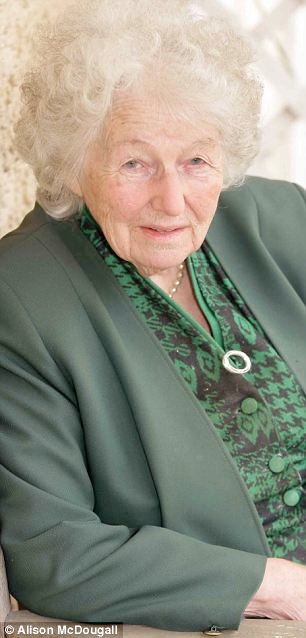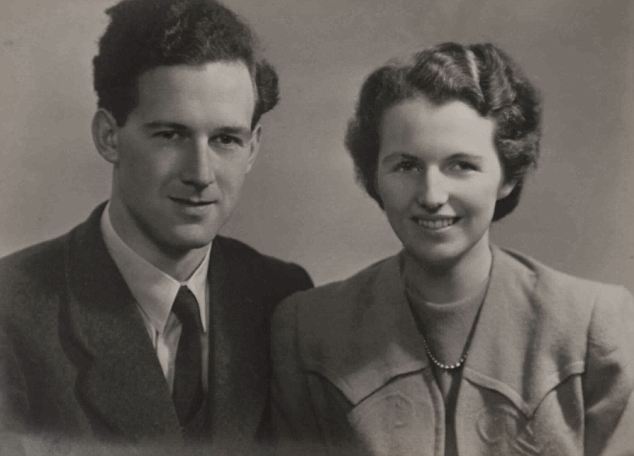Key Bletchley Park codebreaker whose work helped ensure the success of D-Day died on Armistice Day
-
•Mavis Batey worked throughout the war on cracking Axis Enigma codes
-
•Her work on the Italian Enigma led to emphatic Royal Navy victory
-
•Her cracking of the Abwehr Enigma ensured success of Normandy landings
By Damien Gayle
PUBLISHED: 05:42, 14 November 2013 | UPDATED: 09:06, 14 November 2013

Code breaker: Mavis Batey, who has died aged 92, was the last survivor of the Bletchley Park 'break in' experts
One of the leading female codebreakers at Bletchley Park who helped to crack the Axis powers' Enigma code died on Armistice Day at the age of 92.
Mavis Batey was the last surviving of Bletchley's 'break in' experts - codebreakers who worked to crack new ciphers that had never been broken before.
Her achievements included cracking the Italian Navy's Enigma cipher, leading to an emphatic British victory at Matapan, the Royal Navy's first fleet action since Trafalgar.
And she crucially found a way into the Enigma code used by the German secret service, a break which enabled the Double Cross deception that ensured the success of the D-Day landings.
Mavis Lillian Lever was born on May 5, 1921, in Dulwich, South London. She was studying German at University College, London, when the war broke out.
She patriotically decided to break off her studies and enlist as a nurse to help the war effort, but was told that she would be more use to Britain as a German linguist.
Initially she hoped to be a Mata Hari-esque spy, adventuring into occupied Europe to seduce German officers. But she was disappointed.
'I don't think either my legs or my German were good enough because they sent me to the Government Code & Cipher School,' she was quoted as saying by The Times.
After showing promise during a short stint working in London, checking the personal columns in the papers for coded message, she was sent to Bletchley to work on with Dilly Knox, whose research unit led the way in breaking Enigma.
After his initial success with Enigma, Knox, a classic British eccentric, was working on new and as yet uncracked variants.
Nineteen-year-old Mavis was thrust straight in at the deep end, working on the updated Italian Naval Enigma machine. After months of hard work, in late March 1941, she had a breakthrough.
She deciphered a message outlining a large-scale Italian assault on a Royal Navy convoy carrying supplies from Cairo to Greece, which contained the full details of the plan of attack.
'How many cruisers there were, and how many submarines were to be there and where they were to be at such and such a time, absolutely incredible that they should spell it all out,' she recalled.
The message was passed on via the Navy's top brass to Admiral Andrew Cunningham, commander of the Royal Navy's Mediterranean Fleet, giving him the intelligence he needed to pull a fast one on the Italians.
He tricked the Japanese consul in Alexandria, who was passing on information on the fleet's movements to the Germans, into thinking he was having the weekend off to play golf.
Then, under cover of darkness, and with detailed information of the Italian navy's positions, he took the battle to them with a massive fleet action.
Over March 27 and 28, Admiral Cunningham's forces staged a series of surprise attacks on the Italians, sinking three cruisers and two destroyers, actions that cost them 3,000 sailors. The Italians never again dared to sail close to Royal Navy until Admiral Cunningham accepted their surrender in 1943.

War effort: As a 19-year-old Mavis was thrust straight in at the deep end, working on the updated Italian Naval Enigma machine. After months of hard work, in late March 1941, she had a breakthrough
But Mavis's most crucial contribution came in collaboration with Knox and another of his assistants, Margaret Rock, with the cracking of the Enigma code used by the Abwehr, the German secret service.
Britain's own spies had been able to capture most of the agents sent to the UK, and those in the neutral capitals of Lisbon and Madrid, and were using them to feed back false information to Germany.
But no-one knew whether this so-called Double Cross system was working, whether Germany's commanders had been convinced by the fake intelligence sent back.
The Abwehr Enigma was far more complex than the standard version, with its machines using four rotors, rather than the usual three, which rotated randomly with no predictable pattern.
Mavis worked with Knox and Rock to test out every possibility and, on December 8, 1941, she broke a message on the link between Berlin and Belgrade, making it possible to reconstruct one of the rotors.
That was the clue they needed and, within days, Knox's team had broken the Abwehr Enigma. Shortly afterwards, Mavis cracked a second Abwehr cipher, allowing the agents to finally confirm that the Germans believed the phoney intelligence coming from the Double Cross operation.

Love: Mavis pictured with her husband Keith, also a Bletchley Park code breaker, in 1942
Now the time was right for one of the war's most audacious tricks. British agents fed a stream of messages to German commanders informing them that a U.S. Army group was forming in East Anglia and Kent.
As a result, Hitler believed that D-Day's main invasion force was to land on the Pas-de-Calais rather than Normandy, leading him to hold two key armoured divisions in that area.
Field Marshal Montgomery's head of intelligence, Brigadier Bill Williams, later said that without that key deception, the Normandy invasion may well have been a disaster.

War effort: Bletchley Park, Buckinghamshire, where code breakers worked throughout the Second World War
Mavis met her husband, Keith Batey, himself a codebreaker while working at Bletchley Park. After the war she spent some time with the diplomatic service, and then brought up three two daughters and a son.
She has published a number of books on garden history, as well as some relating to Bletchley Park, and has served as President of the Garden History Society, of which she became the secretary in 1971.
She was awarded the Veitch Memorial Medal in 1985, and made a Member of the Order of the British Empire (MBE) in 1987, in both cases for her work on preservation and conservation of gardens.